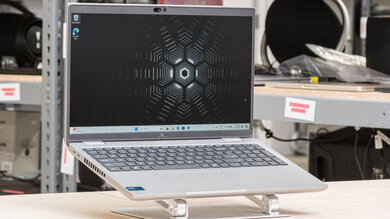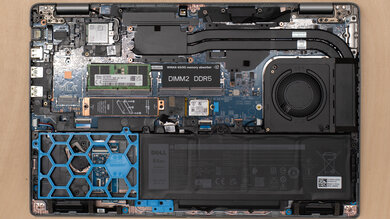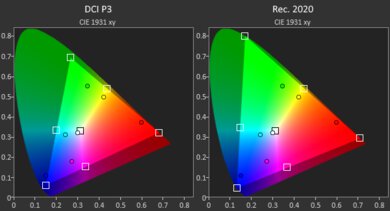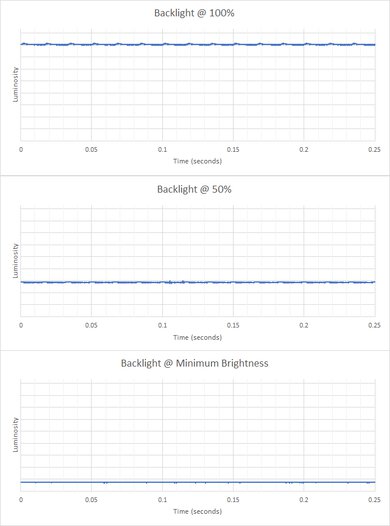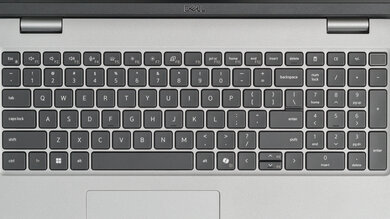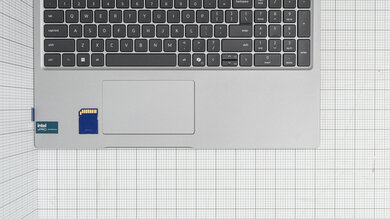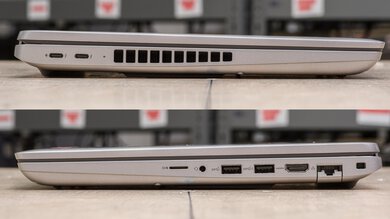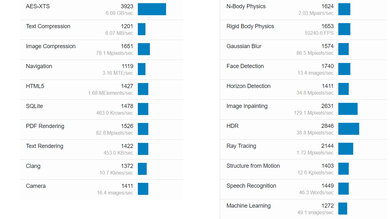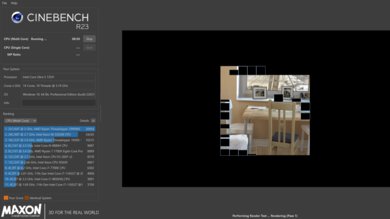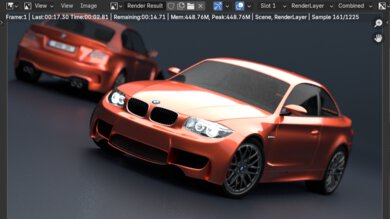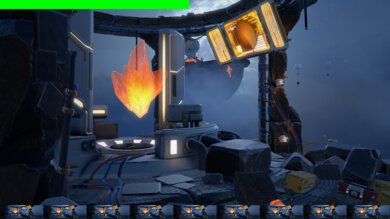The Dell Precision 3591 (2024) is a Windows workstation laptop. It replaces the Dell Precision 3581 from 2023 (Intel 13th Gen). This 3591 model is configurable with Intel Meteor Lake CPUs paired with integrated graphics or an NVIDIA RTX Ada Generation Laptop GPU. It has an FHD display (with or without touch input), a full-size keyboard with a numpad, and a 1080p webcam. Ports include two USB-As, two USB-C/Thunderbolt 4s, an HDMI 2.0, an SD card reader, a 3.5mm headphone jack, and an Ethernet port. You can configure it with a Wi-Fi 6 or 6E wireless adapter, and there's also optional cellular connectivity. Keyboard backlighting and biometrics are optional features.
See our unit's specifications and the available configuration options in the Differences Between Variants section.
Our Verdict
The Dell Precision 3591 is okay for school use. It's available with Intel Meteor Lake CPUs and NVIDIA discrete GPUs, so you can get a fair amount of processing power, making this laptop suitable for students in fields like graphic design and engineering. You can also get it with integrated graphics only if you only need to perform lighter tasks like text processing and web browsing. Unfortunately, the laptop is a little bulky, and the battery life is very short if you get a model with a discrete GPU. You can configure it with a larger 97Wh battery, but you might still need to plug it in to get through the day. Also, the overall user experience isn't great, as the keyboard feels mushy, and the touchpad is quite small.
-
Large screen for multitasking.
-
Intel CPUs and NVIDIA GPUs can handle some demanding workloads.
-
Wide port selection.
-
Slightly bulky.
-
Short battery life on models with a discrete GPU and 64Wh battery.
-
45% NTSC displays look dim and washed out.
The Dell Precision 3591 is decent for gaming. Its Intel CPUs and NVIDIA GPUs can deliver a relatively smooth gaming experience but know that the RTX Ada Generation GPUs are mainly designed for professional workloads, so they don't have the best game drivers and lack features like DLSS and Frame Generation. Also, the available displays are all 60Hz panels with a slow response time, resulting in a blurry image in fast-moving scenes, and none of them support VRR to reduce screen tearing. On the upside, the laptop doesn't get hot or loud under load.
-
Intel CPUs and NVIDIA GPUs can handle some demanding workloads.
-
Wide port selection.
-
User-replaceable RAM and storage.
-
Doesn't get overly hot or loud under load.
-
60Hz displays with slow response time.
-
No VRR support to reduce screen tearing.
-
NVIDIA RTX Ada Generation GPUs lack gaming features like DLSS and Frame Generation.
-
CPU throttles under load.
The Dell Precision 3591 is mediocre for media consumption. It isn't the most portable laptop, as it's a little bulky and heavy. Battery life will depend on which model you get; models with a discrete GPU and a 64Wh battery last around six hours of video playback, but you'll likely get longer if you get a model with integrated graphics and/or a 97Wh battery. The available displays are all 1080p IPS panels, so don't expect to watch anything in 4k or get deep, inky blacks like you would on OLEDs. As for the speakers, they get pretty loud with minimal compression but sound slightly sibilant, with almost no bass.
-
Speakers get pretty loud.
-
400 cd/m² display option with full sRGB coverage.
-
Matte display coating handles reflections well.
-
Slightly bulky.
-
45% NTSC displays look dim and washed out.
-
Speakers sound unnatural, with almost no bass.
The Dell Precision 3591 is a great workstation laptop. It's available with Intel Meteor Lake CPUs and NVIDIA RTX Ada Generation Laptop GPUs, which are powerful enough to handle fairly demanding workloads like 3D graphics and simulations. RAM and storage are user-replaceable, so you can easily add or upgrade later. Its excellent port selection includes Thunderbolt 4s and an HDMI, allowing you to transfer files quickly and connect multiple external displays. Unfortunately, two of the available displays aren't suitable for color-critical work due to their poor color gamut, and the third only has full sRGB coverage.
-
Intel CPUs and NVIDIA GPUs can handle some demanding workloads.
-
Wide port selection.
-
User-replaceable RAM and storage.
-
Doesn't get overly hot or loud under load.
-
45% NTSC displays aren't suitable for color-critical work.
-
CPU throttles under load.
-
Limited GPU options.
The Dell Precision 3591 is good for business use. Its Meteor Lake CPUs can easily handle general productivity tasks like text processing, spreadsheets, and presentations. The available displays are all 1080p panels; they look reasonably sharp, though you'll have to get the highest-end option if you work in a bright environment, as the other panels are quite dim. It has a good 1080p webcam and a wide port selection, and you can even get the laptop with cellular connectivity if you need to work on the go. Battery life will depend on the configuration—we recommend upgrading to the larger 97Wh battery. Unfortunately, the keyboard feels mushy, and the touchpad is small.
-
Large screen for multitasking.
-
Wide port selection.
-
Good 1080p webcam.
-
Optional cellular connectivity.
-
Slightly bulky.
-
Short battery life on models with a discrete GPU and 64Wh battery.
-
45% NTSC displays look dim and washed out.
- 6.8 School
- 7.1 Gaming
- 6.1 Multimedia
- 8.7 Workstation
- 7.5 Business
- Updated Sep 16, 2024: Added mention of the Dell Precision 5690 (2024) as an alternative with more powerful GPU options for professional workloads in the GPU section.
- Updated Aug 27, 2024: Added mention of the HP ZBook Power G11 A (2024) as an alternative with longer battery life in the Battery section.
- Updated Aug 23, 2024: Review published.
- Updated Aug 19, 2024: Early access published.
- Updated Aug 09, 2024: Our testers have started testing this product.
- Updated Jul 31, 2024: The product has arrived in our lab, and our testers will start evaluating it soon.
- Updated Jul 17, 2024: We've purchased the product and are waiting for it to arrive in our lab.
Differences Between Sizes And Variants
We tested the Dell Precision 3591 equipped with an FHD IPS display, an Intel Core Ultra 5 135H CPU, an NVIDIA RTX 500 Ada Generation discrete GPU, 16GB of RAM, and 512GB of storage. The display, CPU, GPU, memory, and storage are configurable; the available options are in the table below.
| Display |
|
|---|---|
| CPU |
|
| GPU |
|
| Memory |
|
| Storage |
|
|
Color |
|
See our unit's label here.
Compared To Other Laptops
The Dell Precision 3591 is a good workstation laptop if you just need a basic laptop that can handle relatively demanding tasks. There are better options in its price range that provide more processing power and a superior user experience overall. Also, configuring the laptop on Dell's website can be quite challenging due to the sheer number of configurations and restrictions, with features such as keyboard backlighting and biometrics being optional rather than the baseline.
See our recommendations for the best laptops for programming, the best Dell laptops, and the best laptops for video editing.
The Dell Precision 3591 (2024) and the Dell XPS 15 (2023) are both high-performance laptops designed to handle demanding tasks. However, the Precision is better suited for professionals in 3D graphic design and simulation, as it uses NVIDIA RTX Ada Generation Laptop GPUs, while the XPS is more of a content creator laptop, sporting the more consumer-oriented GeForce GPUs. In terms of the user experience, the XPS wins hands down, as it's a more premium laptop with higher-end materials and build.
The Dell Precision 3591 (2024) is a newer version of the Dell Precision 3571 (2022). They're very similar when it comes to the build and overall user experience, though the older 3571 has more display options, including a much nicer 4k panel. CPU performance will depend on which configuration you get; however, the 3591 doesn't throttle as much under load. Also, the 3591 is available with more powerful NVIDIA RTX Ada Generation Laptop GPUs.
The Apple MacBook Pro 16 (M3, 2023) is much better than the Dell Precision 3591 (2024) in almost every way. The MacBook Pro is a higher-end device with a more premium build and provides a better user experience overall. It has a nicer Mini LED display, a more tactile keyboard, a larger and more responsive touchpad, better-sounding speakers, and a significantly longer battery life. It also gives you more processing power to tackle highly intensive workloads.
The Lenovo ThinkPad P1 Gen 7 (2024) is much better than the Dell Precision 3591 (2024). The ThinkPad is a more premium laptop that provides a better user experience. It has a better keyboard, a larger haptic touchpad, a higher-quality webcam, and a significantly longer battery life. Also, it's available with sharper, brighter displays, including a 4k+ OLED panel. While both laptops are configurable with Intel Meteor Lake CPUs and NVIDIA GPUs, the ThinkPad has more options, as you can get it with a GeForce or RTX Ada Generation Laptop GPU, and it has a higher-end RTX 3000 Laptop GPU option as well.
The HP ZBook Power G11 A (2024) is a better laptop for most uses than the Dell Precision 3591 (2024). These are both Windows workstation laptops and, as a result, have similar features. Both have a very wide port selection, Wi-Fi 6E connectivity, and options for NFC support. They also both support a variety of new CPUs and NVIDIA discrete GPUs, so you can scale the hardware performance up or down depending on your workflow needs. Where the HP excels is its user experience. Its battery lasts three times as long, and it has a great keyboard and trackpad.
The Dell Precision 5690 (2024) is a higher-end and much better workstation laptop than the Dell Precision 3591 (2024). The 5690 is a more premium laptop that provides a better user experience. It has a larger haptic touchpad, much better-sounding up-firing speakers, and significantly longer battery life. Also, it's available with sharper, brighter displays, including a 4k+ OLED panel. While both laptops are configurable with Intel Meteor Lake CPUs and NVIDIA GPUs, the 5690 gives you more options; you can get it with up to an NVIDIA RTX 5000 Ada Generation Laptop GPU. One niche use case the 3591 presents over the 5690 is its compatibility with cellular networks. If you need a laptop with mobile connectivity for remote or on-the-go use, then the 3591 is the better option.
Test Results
The Dell Precision 3591 is only available in the Silver color. See the bottom of the laptop here.
The Dell Precision 3591's build quality is decent. Though entirely plastic, the chassis feels relatively sturdy, exhibiting only a small amount of flex on the keyboard deck. The lid flexes slightly more, and the display twists a bit when manipulating it, but these issues aren't severe enough to be of concern. That said, the device as a whole feels heavy and clunky, with uneven weight distribution. The finish doesn't easily scratch or pick up fingerprints, and the feet feel solid.
The Dell Precision 3591's serviceability is outstanding. Accessing the internals is very easy; you only need to remove eight Philips screws and release the bottom panel's clips with a prying tool. The screws are captive, meaning they remain attached to the bottom panel, so you don't have to worry about losing them. Both M.2 storage slots support 2230 and 2280 PCIe Gen 4 NVMe SSDs. The slot labeled 'MLK'—no, not that MLK—is for a WWAN adapter (cellular connectivity).
See the owner's manual here.
The Dell Precision 3591 is available with the following displays:
- 15.6" IPS 1920 x 1080 60Hz (45% NTSC)
- 15.6" IPS 1920 x 1080 60Hz (Touchscreen, 45% NTSC)
- 15.6" IPS 1920 x 1080 60Hz (100% sRGB)
A 1080p resolution looks reasonably sharp on a 15.6-inch display. You can see individual pixels up close, but it isn't a huge issue at typical viewing distances. As for the aspect ratio, a taller 16:10 or even a 3:2 would have been preferable for productivity, as the increased vertical space lets you see more information at once, so you don't have to scroll as much.
The Dell Precision 3591 is only available with 60Hz displays. Our unit's non-touch, 45% NTSC panel has a slow response time, resulting in visible ghosting behind fast-moving objects. The other panels have the same 35ms advertised response time. None of the available displays support variable refresh rate.
The 45% NTSC display's contrast ratio is okay and within the typical range of most IPS panels. However, it's still relatively low compared to other display technologies like VA and OLED. This contrast level makes blacks look gray in dim settings. The 100% sRGB panel has a slightly higher advertised contrast ratio, but it isn't enough to make much difference visually.
The 45% NTSC panel is pretty dim, so it's only suitable for indoor use. Even then, you might have visibility issues if there's bright lighting, like sunlight through an open window. The touch-sensitive display has the same brightness, while the 100% sRGB panel has an advertised brightness of 400 cd/m².
The display's matte coating handles direct, mirror-like reflections well. The biggest problem is when viewing dark color content, as the finish causes a halo effect around bright light sources.
The display's horizontal viewing angle is mediocre. The image dims and washes out quickly as you move to the side, so you need to be more or less directly in front of the screen to get perfect accuracy.
The display's vertical viewing angle is mediocre. Like the horizontal viewing angle, the image dims and washes when viewing from above and below, so you need to look at the screen more or less straight on to see an accurate image. This can be challenging in tight places with little room to tilt the screen, like on a bus or airplane.
The 45% NTSC display's accuracy is bad out of the box. The color dE is high because the panel has a narrow color gamut and can't reproduce the highly saturated primary colors. Also, the color temperature is too cool, giving the entire image a noticeable blueish tint. The gamma is far too high in dark and bright scenes, making them look darker than they should.
The 45% NTSC display has a poor color gamut. It doesn't even have full coverage of the commonly used sRGB color space, making most web content look washed out. This panel isn't suitable for any type of color work, like photo and video editing. Naturally, the 100% sRGB panel has full sRGB coverage, but don't expect to do anything in Adobe RGB or DCI P3.
The Dell Precision 3591 provides an okay typing experience. Its layout is fairly standard, so it's easy to get used to. The keys have a good amount of travel; however, they're somewhat unstable, require a fair amount of force to actuate, and feel mushy. They're also on the smaller side, which can lead to more typos. Backlighting is optional, so make sure to check the specs if it matters to you.
The Dell 3591's touchpad is okay. It tracks all movements and gestures well; it's just small, which makes actions like dragging and dropping over a long distance more challenging. Palm rejection works as intended. This is a diving board touchpad, so you can only click in the bottom half. Unfortunately, the buttons feel mushy.
The Dell Precision 3591's speakers get pretty loud with minimal compression at high volume levels. However, they sound unnatural and slightly sibilant, with almost no bass whatsoever.
The Dell Precision 3591 has a good webcam. The image has a decent amount of fine details but also looks a bit soft, with some noise in darker areas. Colors look okay, though the color temperature is quite warm. Voices sound loud and clear over the microphone, with little to no background noise. The privacy cover is only a physical barrier and doesn't disable the camera or the microphone at the software level. You can manually turn off the microphone using the F4 shortcut.
The Dell Precision 3591 has an excellent port selection. Both USB-As support USB 3.2 Gen 1 data transfer speed of up to 5Gbps. The one closest to the HDMI port is always on, meaning you can use it to charge a mobile device even when the laptop is in sleep mode. The USB-Cs support Thunderbolt 4 (up to 40Gbps data transfer speed and two 4k @ 60Hz displays) and DisplayPort. However, the one closest to the back connects to the discrete GPU and can take up to 130W of power (to charge the laptop), while the other connects to the integrated graphics and can only take up to 100W. As for the HDMI port, Dell advertises HDMI 2.1, but it uses the TMDS (Transition-minimized differential signaling) signaling method and can only output at a maximum resolution of 4k @ 60Hz. As such, we consider it an HDMI 2.0.
The Dell Precision 3591's wireless adapter is an Intel Wi-Fi 6E AX211. You can also get this laptop with a Realtek Wi-Fi 6 RTL8852BE or with no adapter installed. Wi-Fi 6E gives you access to the 6GHz band, providing faster speeds, lower latency, and less signal interference than previous wireless standards; however, you need a router that supports Wi-Fi 6E to benefit from these features.
Optional cellular connectivity is available. You can configure the laptop with a 4G Qualcomm Snapdragon X12 (DW5825e) or a 5G Qualcomm Snapdragon X62 (DW5932e) adapter.
The Dell Precision 3591 is available with the following CPUs:
- Intel Core Ultra 5 135H (14 cores/18 threads, up to 4.60GHz, 18MB cache)
- Intel Core Ultra 7 155H (16 cores/22 threads, up to 4.80GHz, 24MB cache)
- Intel Core Ultra 7 165H (16 cores/22 threads, up to 5.00GHz, 24MB cache)
- Intel Core Ultra 9 185H (16 cores/22 threads, up to 5.10GHz, 24MB cache)
All four CPUs are high-performance, 45W processors from Intel's Meteor Lake family. Like Intel's 13th Gen CPUs, they have a hybrid architecture comprising performance and efficiency cores. However, they have two additional low-power E-cores (LP-E) to further improve efficiency, as well as an NPU (Neural Processing Units) to speed up A.I. tasks, like background-blurring on video calls and image generation in photo editing apps. These CPUs can handle general productivity tasks and more intensive workloads, like programming, video editing, and 3D graphics. That said, they aren't the fastest Intel has to offer, as they still lag behind the 14th Gen HX CPUs, like the Dell Alienware m18 R2 (2024)'s Intel Core i9-14900HX. Regarding core composition, the Core Ultra 5 has four performance cores, eight efficiency cores, and two low-power efficiency cores (4P+8E+2LP-E), while the Core Ultra 7s and 9 have six performance cores, eight efficiency cores, and two low-power efficiency cores (6P+8E+2LP-E). All four CPUs have the same Neural Processing Units (NPU).
See more information about the Intel Meteor Lake CPUs here.
The Dell Precision 3591 is available with the following GPUs:
- Intel Arc Graphics (integrated)
- NVIDIA RTX 500 Ada Generation Laptop GPU 4GB GDDR6 (discrete, 45W TGP /w Dynamic Boost)
- NVIDIA RTX 1000 Ada Generation Laptop GPU 6GB GDDR6 (discrete)
- NVIDIA RTX 2000 Ada Generation Laptop GPU 8GB GDDR6 (discrete)
The RTX Ada Generation GPUs are designed mainly for professional workloads like design and simulation. The available options range from entry-level to lower mid-range. Considering solely the number of CUDA cores, the RTX 1000 is akin to the gaming-oriented GeForce RTX 4050 Laptop GPU with 2,560 CUDA cores, while the RTX 2000 has the same number as the RTX 4060, with 3,072 CUDA cores. The RTX 500 is the weakest, sporting 2,048. Ultimately, the choice of the GPU depends on your workload, its complexity, and the speed at which you expect to complete tasks. You can play games on models with an RTX Ada Generation GPU; just know that the performance won't be as good as on models with a GeForce GPU, as they don't always get the best drivers. You can also get this laptop with Intel-integrated graphics only if you don't need a lot of GPU processing power. Dell doesn't specify the TGP (Total Graphics Power). The RTX 1000 and 2000 can technically run up to 140W, but they likely run at the same 45W as the RTX 500, given this laptop's limited cooling system. If you need more power GPU options, consider the Dell Precision 5690 (2024).
See more information about the NVIDIA RTX Ada Generation Laptop GPUs here.
You can configure the Dell Precision 3591 with 8GB, 16GB, 32GB, or 64GB of non-ECC (Error Correction Code) RAM. Some configurations come in single-channel mode, which will limit performance, so it's best to get a dual-channel configuration if you don't plan on upgrading the device yourself.
You can configure the Dell Precision 3591 with 256GB, 512GB, 1TB, or 2TB of storage. You can add a second drive in a RAID 0 or RAID 1 array. RAID 0 will give you the best speeds, but know that the failure of one drive can cause data loss across both drives.
The Dell Precision 3591's Intel Core Ultra 5 135H CPU scores well in the Geekbench 5 benchmarks. It can handle a variety of productivity tasks, including some demanding workloads like programming, but if performance is important, it's best to upgrade to the Core Ultra 7 or 9, as they'll perform noticeably better in multi-threaded applications. All three discrete GPUs can handle heavy computing tasks, so you can simply choose depending on the complexity of your work and the speed at which you expect to complete tasks. Intel's integrated graphics perform poorly and aren't suitable for such workloads.
The posted results are scores obtained in the default Optimized setting. Switching to the Best Performance mode has very little effect. Here are the scores:
- Single-thread: 1,665 (less than 1% difference)
- Multi-thread: 9,216 (less than 1% difference)
- GPU Compute: 64,767 (+3%)
The Dell Precision 3591's Intel Core Ultra 5 135H performs well in the Cinebench R23 benchmark. Its multi-thread performance is better than what we typically see on thin and light laptops; however, it's by no means exceptional. If you have a heavily multi-threaded workload, it's best to upgrade to the Core Ultra 7 or Core Ultra 9, as they have two additional performance cores.
The posted results are scores obtained in the Optimized mode. Again, switching to the Best Performance mode has little to no effect.
The Dell Precision 3591 is excellent for Blender work. Just make sure you get a model with a discrete GPU—even the lowest end NVIDIA RTX 500 Ada Generation Laptop GPU will render images faster than the CPU and integrated graphics.
The Dell Precision 3591's NVIDIA RTX 500 Ada Generation Laptop GPU is a low-end discrete GPU designed for professional workloads. It can handle demanding AAA games at 1080p, but you'll have to dial down the settings to get smooth gameplay. Based on the score, its performance is in the same ballpark as an NVIDIA GeForce RTX 3050; however, remember that these Ada Generation GPUs lack support for gaming features like DLSS and Frame Generation to boost the frame rate. The RTX 1000 and 2000 will fare better, with the latter capable of handling some games at 1440p, but again, the performance will vary, as these GPUs don't always have the best drivers.
Models with integrated graphics only will have longer battery life. You can also get this laptop with a 97Wh battery, which is roughly a 51% increase in capacity over the 64Wh battery. If you want a workstation with a much better battery life, consider the HP ZBook Power G11 A (2024).
Borderlands 3 doesn't run particularly well on the Dell 3591 with an NVIDIA RTX 500 Ada Generation Laptop GPU. You can get over 60 fps with low settings, but the gameplay is still choppy due to frame drops. Models with an RTX 1000 or 2000 will perform better, but again, you might still experience frequent stutters.
Every configuration can handle Civilization VI and other similarly demanding games with no issues. However, you'll have to turn down the settings to get playable frame rates when using Intel's integrated graphics.
You can get over 60 fps in Counter-Strike 2 and other similarly demanding games on models with a discrete GPU, but the gameplay isn't very smooth, as there are frequent stutters. This game isn't playable with Intel's Arc iGPU.
Shadow of the Tomb Raider and other similarly demanding games are playable on models with a discrete GPU, but you might experience occasional stutters. Intel's Arc iGPU can't handle such a graphically intensive game.
The posted results are measurements taken in the default Optimized setting. You can change the fan setting in the Dell Optimizer app.
The Dell Precision 3591 has many pre-installed software applications, including:
- Dell Command: Checks for BIOS, driver, or firmware updates.
- Dell Digital Delivery: Lets you download software applications purchased from Dell.
- Dell Display Manager: Lets you organize your screen when using multiple windows and customize your display settings.
- Dell Optimizer: Lets you monitor the laptop's battery health, storage, CPU status, and network usage. It also allows you to change performance and fan settings and can automatically optimize the system to extend battery life or improve performance.
- Dell Pair: Helps detect and pair peripherals via Bluetooth.
- Dell Peripheral Manager: Lets you control video calls, share your screen, customize and update Dell accessories, and apply noise cancelation during video calls.
- Dell SupportAssist: Lets you scan for drivers and hardware issues, clean files, optimize performance, and access system activity history.
- Dell Trusted Device Agent: Detects BIOS tempering.
You can get this laptop with Windows 11 Home, Windows 11 Pro, or Ubuntu 22.04 pre-installed.
The Dell 3591's fingerprint sensor and IR facial recognition camera are optional features. You can use either to log in quickly, authorize purchases in the Windows Store, and auto-fill saved passwords on supported websites. You can also add a Smart Card Reader and/or NFC support.


